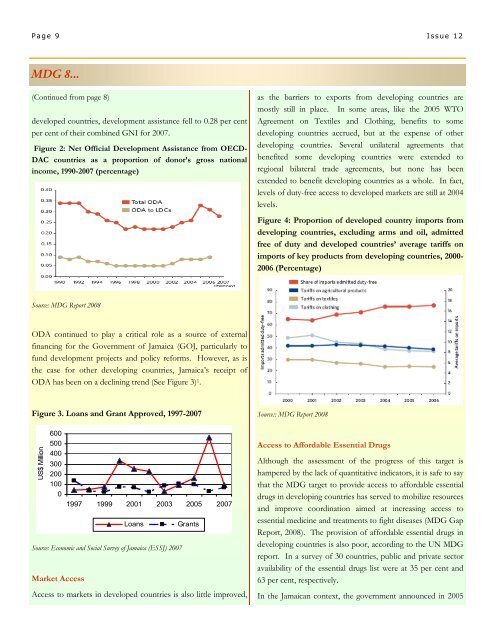Beginnings Issue 12.pub - Planning Institute of Jamaica
Beginnings Issue 12.pub - Planning Institute of Jamaica
Beginnings Issue 12.pub - Planning Institute of Jamaica
You also want an ePaper? Increase the reach of your titles
YUMPU automatically turns print PDFs into web optimized ePapers that Google loves.
P a g e 9 I s s u e 12<br />
MDG 8...<br />
(Continued from page 8)<br />
developed countries, development assistance fell to 0.28 per cent<br />
per cent <strong>of</strong> their combined GNI for 2007.<br />
Figure 2: Net Official Development Assistance from OECD-<br />
DAC countries as a proportion <strong>of</strong> donor’s gross national<br />
income, 1990-2007 (percentage)<br />
as the barriers to exports from developing countries are<br />
mostly still in place. In some areas, like the 2005 WTO<br />
Agreement on Textiles and Clothing, benefits to some<br />
developing countries accrued, but at the expense <strong>of</strong> other<br />
developing countries. Several unilateral agreements that<br />
benefited some developing countries were extended to<br />
regional bilateral trade agreements, but none has been<br />
extended to benefit developing countries as a whole. In fact,<br />
levels <strong>of</strong> duty-free access to developed markets are still at 2004<br />
levels.<br />
Figure 4: Proportion <strong>of</strong> developed country imports from<br />
developing countries, excluding arms and oil, admitted<br />
free <strong>of</strong> duty and developed countries’ average tariffs on<br />
imports <strong>of</strong> key products from developing countries, 2000-<br />
2006 (Percentage)<br />
Source: MDG Report 2008<br />
ODA continued to play a critical role as a source <strong>of</strong> external<br />
financing for the Government <strong>of</strong> <strong>Jamaica</strong> (GOJ, particularly to<br />
fund development projects and policy reforms. However, as is<br />
the case for other developing countries, <strong>Jamaica</strong>’s receipt <strong>of</strong><br />
ODA has been on a declining trend (See Figure 3) 1 .<br />
Figure 3. Loans and Grant Approved, 1997-2007<br />
US$ Million<br />
600<br />
500<br />
400<br />
300<br />
200<br />
100<br />
0<br />
Source: Economic and Social Survey <strong>of</strong> <strong>Jamaica</strong> (ESSJ) 2007<br />
Market Access<br />
1997 1999 2001 2003 2005 2007<br />
Loans<br />
Grants<br />
Access to markets in developed countries is also little improved,<br />
Source:: MDG Report 2008<br />
Access to Affordable Essential Drugs<br />
Although the assessment <strong>of</strong> the progress <strong>of</strong> this target is<br />
hampered by the lack <strong>of</strong> quantitative indicators, it is safe to say<br />
that the MDG target to provide access to affordable essential<br />
drugs in developing countries has served to mobilize resources<br />
and improve coordination aimed at increasing access to<br />
essential medicine and treatments to fight diseases (MDG Gap<br />
Report, 2008). The provision <strong>of</strong> affordable essential drugs in<br />
developing countries is also poor, according to the UN MDG<br />
report. In a survey <strong>of</strong> 30 countries, public and private sector<br />
availability <strong>of</strong> the essential drugs list were at 35 per cent and<br />
63 per cent, respectively.<br />
In the <strong>Jamaica</strong>n context, the government announced in 2005
















